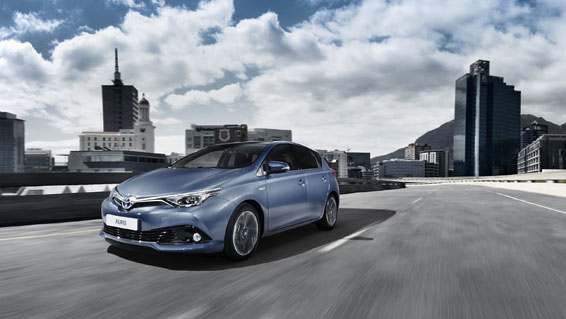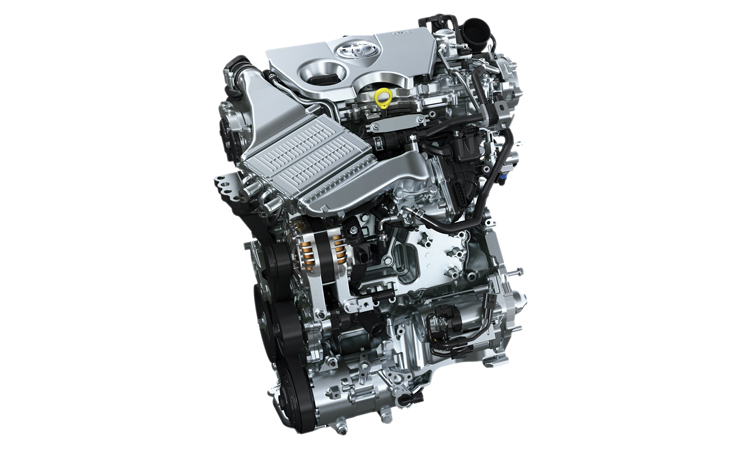The Toyota 1.2T, an all-new, direct injection turbocharged petrol engine, makes its global debut in the new Toyota Auris.
It belongs to the range of 14 new engines that Toyota is launching globally between April 2014 and the end of 2015.
Last year Toyota announced its plan to introduce a series of new, highly fuel-efficient engines, created using a number of combustion and loss-reduction technologies that had previously been reserved for hybrid engines.
See also:
LIVE – Toyota at the 2015 Geneva Motor Show
New Toyota Auris 2015 revealed
Toyota Auris 2015: design explained
Toyota Auris 2015: engine line up explained
The new four-cylinder 1.2T engine is the second unit from this family to come to Europe bearing the Toyota badge, following on from the three-cylinder 1.0-litre engine that was introduced in new Aygo and Yaris in 2014.
Like the 1.0-litre, the 1.2T uses advanced technologies that allow it to change from the Otto to the Atkinson cycle when running under low loads, vertical vortex high tumble air flow intake ports, an exhaust manifold integrated in the cylinder head and advanced heat management measures.
The 1.2T adds to this a direct injection system and a water-cooled turbo and heat exchanger. Furthermore, the VVT-i intelligent variable valve timing system featured on the 1.0-litre is upgraded to a VVT-iW (Variable Valve Timing – intelligent Wide) system, which allows even more valve timing flexibility.
The combination of these technologies results in outstanding performance and efficiency.
With a displacement of just 1,197cc, the engine delivers 114bhp (85kW) and constant torque of 185Nm between 1,500 and 4,000rpm. It will push the new Auris hatchback from rest to 62mph in 10.1 seconds. Acceleration from 50 to 75mph in fifth gear takes 13.7 seconds, and top speed is set at 124mph.
All of this is achieved despite a focus on fuel economy and CO2 emissions: the car achieves 60.1mpg* on the combined cycle and 109g/km* of CO2.
Securing better performance with higher efficiency
The key to achieving this level of fuel consumption without compromising performance is to apply higher compression, but generally, as compression increases, so does the risk of uncontrolled combustion – “knocking”.
The 1.2T’s high 10:1 compression ratio has been made possible thanks to a series of technologies that improve control of the combustion process. This way, the risk of knocking can be avoided.
First, the intake ports have been designed to generate a more intense flow and a “vertical vortex” and the piston shape has been optimised to improve in-cylinder turbulence. As a result, fuel and intake air mix faster and form a more homogenous mixture. This leads to a higher combustion speed, which helps prevent knocking.
Advanced heat management in itself is a great way to improve fuel economy, but it is also another way to reduce the risk of knocking. The 1.2T engine was designed in such a way that the temperature of each individual part can be optimised. For example, the bottom of the pistons is cooled by oil jets and the cooling of the cylinder head is separate from that of the engine block. This means the temperature in the combustion chamber can be reduced, while keeping the block itself hot enough to reduce friction.
Direct injection makes a contribution as well, as it helps dissipate the heat in the combustion chamber, and the charge air passes through the intercooler, which uses a low-temperature cooling circuit.

1.2T: low-end torque and quick response
A low-inertia turbocharger, the VVT-iW valve system and the D-4T direct injection system work together to ensure excellent torque delivery, from the lowest engine speeds.
Together with the limited-volume intake system, this ensures immediate response when the accelerator pedal is pressed.
The injection system has been newly developed for the 1.2T engine. Compact in design, it is perfect for use in a small displacement engine. It allows multiple injections per cycle and the optimised width and reduced length of the spray pattern ensure combustion quality, regardless of engine regime and load.
From Otto to Atkinson
The VVT-i system operates on both the intake and the exhaust side, and allows torque to be maximised at all engine speeds. In addition, the VVT-iW allows for intake valve closing to be delayed, which means the engine can operate in both the Otto and Atkinson cycle.
The Atkinson cycle is used in extremely low engine load conditions, when the intake valve remains open for a fraction of time, after the compression stroke has set in, allowing part of the gas charge to be pushed back into the intake. As a result, the effective compression stroke is shortened.
Pumping losses are reduced, as there is less pressure on the piston, and the throttle valve can be opened wider.
Quick and smooth stop and start
A new start control has been developed to ensure quick and smooth engine restart. When the system shuts down the engine, it controls the stop position to leave the piston half way in the compression stroke.
On restart, it applies stratified injection in the first compressed cylinder to counter vibrations. And by retarding the ignition, torque increase is kept in check, preventing the engine from revving excessively, thus ensuring a calm and confident take-off.
| Toyota Auris 1.2T | Technical specifications |
|---|---|
| Engine type | 4-cylinder in-line |
| Injection | Direct |
| Displacement (cc) | 1,197 |
| Bore x stroke (mm) | 71.5 x 74.5 |
| Compression ratio | 10:1 |
| Max. power (bhp/kW @rpm) | 114/85 @ 5,200 – 5,600 |
| Specific power (bhp/litre) | 95.2 |
| Max. torque (Nm @ rpm) | 184 @ 1,500 – 4,000 |
| Specific torque (Nm/litre) | 154.6 |
| CO2 emissions (g/km, EU combined cycle) 6MT | 109 |
| CO2 emissions (g/km, EU combined cycle) CVT | 106 |
| Max speed (mph) | 124 |
| 0-62mph (sec) | 10.1 |





Is it advisable to wait 30s before turning the egine off after driving at high rpms just like any other turbo charged car? Or there’s no need to wait 30 secs with the CHR? Also, is it ok to install an after market dump valve on it?
Hi Kooshal,
Thanks for getting in touch.
The C-HR 1.2 features a turbocharged engine. Therefore, it is advisable to let the engine idle for approximately 1 minute after the vehicle has been driven at high load conditions for a long period of time. This will allow the turbocharger to cool down and will ensure the longevity of this component.
In regards to the damp valve, we would not recommend the use of any after-market components.
We hope this helps.
Thanks. Do you not recommend the use of after-market dump valves for the CHR only, or do you not recommend it for all turbo charged engines?
We would not recommend the use of any after-market dump valve on any Toyota turbocharged engine.
We are also unable to confirm on whether or not there would be any possible side effects to the engine as a result of using these dump valves.
Hope this helps.
Good morning, could I mount an LPG system on this 1.2 T engine? Would it make some damages to the valves? Is there any precautions to be taken?
Thank you in advance
Hi Marco,
Thanks for getting in touch. If you could please provide a reg or VIN number, we will be able to assist you further.
Thanks.
Please a word of advice to Toyota team
Toyota yaris gr with 1.2 turbo and there you go, they can thank me later for winning combo.
Hi,
Thanks for your feedback. We have passed it to the product team for consideration. All the best.
Hi,
Can anyone help me to get a avensis 2016/2017 brochure pdf,
Regards
Mike
Hi Mike,
Thanks for getting in touch. We will email you directly regarding your query.
Thanks.
Hi,
has the intake valve carbon deposit problem been addressed?
Hi Nick,
Thanks for getting in touch. We will check this with our technical team and let you know as soon as we can. Thank you for your patience.
Thanks.
It’s a year later and no reply? From what I can see, the 1.2T engine still suffers from that problem as shown in the Toyota technical papers. The only engines that have dual injections systems at this date are the 2.0L Dynamic Force Engine and the 2.0L and 2.5L D-4S engines.
Hi Frank,
Thanks for getting in touch.
We’d recommend contacting the Toyota distributor in your region for further help with your query as specifications differ between markets.
Thanks.
Wich kind of engine oil have use for auris NRE185 120T?
Hi Mark,
Thanks for getting in touch. We would recommend contacting Toyota in your region for further help with this.
Thanks.
Can you use redex in the 1.2 engine or will it cause problems
Hi David,
Thanks for getting in touch with us.
No, we wouldn’t specifically recommend using fuel additives. However, if you were to use the correct volumes, we don’t think you’d experience any issues.
Thanks.
Hi. I want to buy oil for my car and thinking about Petronas 7000 hybrid 0w20 API SN PLUS , ILSAC GF – 5 , Dexos 1 gen 2. Can you just tell me its ok to use this oil in my engine. Reg FJ16ULB. What is a different when label showing hybrid if spec are the same.
Hi Radek,
Thanks for getting in touch.
We’ve checked with our technical team, and this oil is suitable for your vehicle as it is the correct viscosity and API grade.
Oils are being labelled that way to not only appeal to the hybrid market – there can also be certain benefits from additives that support the operating conditions of a hybrid vehicle engine.
Thanks.